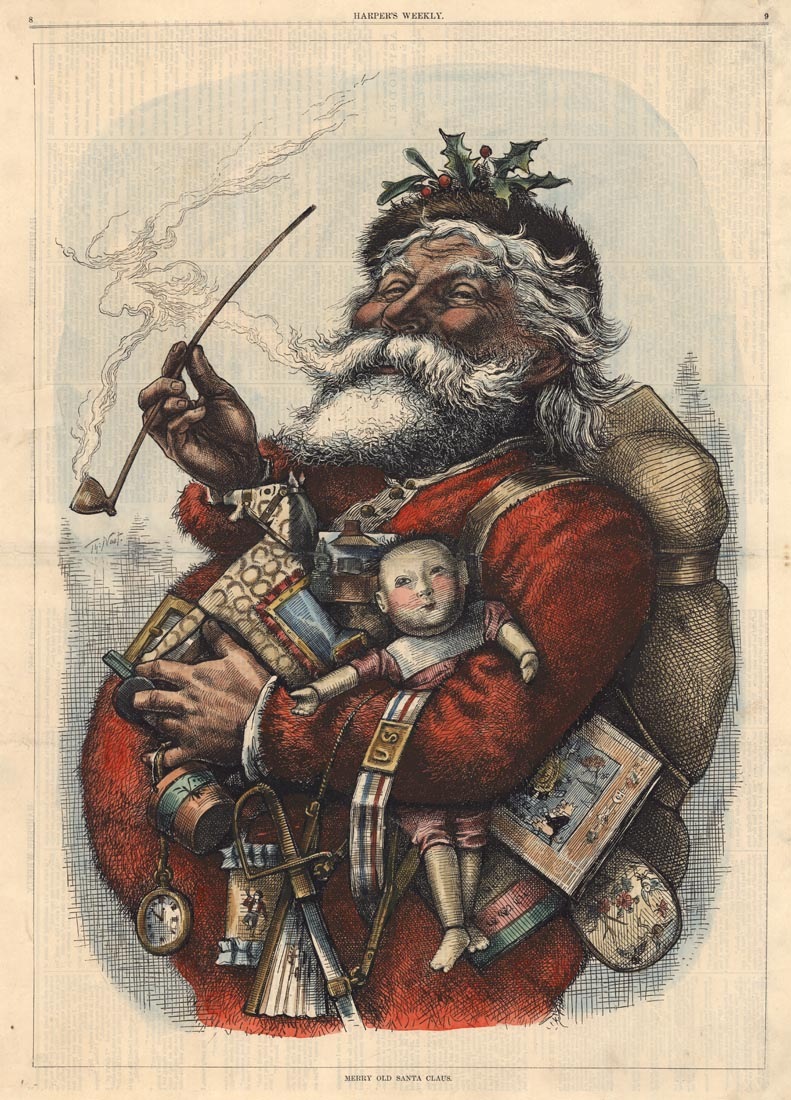Remember Asterix and his band of indomitable Gauls holding out against an ever-impending invasion? The wily warrior is often said to symbolize France’s valiant stand against encroaching cultural influences, especially from the United States. And indeed the eponymous books were originally created in 1959 to counter an onslaught of U.S. comic strips such as Superman and Archie. But one American invasion that even Asterix has found hard to repel is the one spearheaded by Santa Claus and his minions, who come not from Lapland or the North Pole but from New York via Washington (Irving).
But wait a minute: Christmas is a Christian religious festival, right? Well, not exactly. For starters, some non-Christian holidays, most obviously African American Kwanzaa and Jewish Hanukkah, are celebrated more or less contemporaneously. All of these celebrations blend into a broader holiday season. Which is partly why Americans tend to wish each other “Happy holidays” rather than simply “Happy Christmas.”
What’s more, the feast of Christmas was totally absent from Christian liturgy and rituals until relatively recently. According to French ethnologist and Noël-ologist Martyne Perrot, it’s a “social invention established over time and consolidated in accordance with economic and political strategies.” And its roots, she says, are “clearly Anglo-Saxon” – which basically means “invented by Americans, then fobbed onto the rest of the English-speaking world.” Leaving Perrot’s notion of strategy aside for a minute, most people would certainly agree that the modern-day celebration of Christmas has more to do with Mammon than with religion. How have things come to this not-so-pretty pass?
It all goes back to Father Christmas. The basic story that spawned the Santa myth is well-known. It begins with Saint Nicholas of Myra, an early Christian bishop in Asia Minor renowned for his generosity and patronage of the poor. The bishop’s legend as a giver of gifts and worker of miracles gained traction during the centuries after his death, and his relics were moved from their resting place in Myra (now the Turkish city of Demre) to various locations in Europe, including France, where he became the patron saint of Lorraine. (The French connection was further strengthened in the 15th century when Saint Nicholas miraculously helped to repel an invasion by the Duke of Burgundy.)
A hundred years later, the saint was well established in the culture and traditions of countries farther afield, notably the Netherlands, where his Dutch name, Sint-Nicolaas, was conflated to Sinterklaas. When a group of persecuted Calvinists fled Holland for the New World, they took the venerated bishop along with them in their cultural baggage and ultimately turned him into a political figure. The Saint Nicholas story allowed the Pilgrim Fathers and their descendants to thumb their noses at the British colonial rulers by inventing their own tradition for the winter solstice and even to go head-to-head with Saint George as a national figurehead. Thus did Nicholas become a symbol of America’s non-English past.
Over the next two centuries, Sinterklaas was honored on his saint’s day on December 6 by the descendants of the Dutch settlers. But there was none of the hoopla that we now associate with Christmas. So how did this austere saint, usually depicted as a tall, thin man clad in blue and accompanied by an angel, morph into Santa Claus, that affable, red-cheeked and white-bearded bringer of jollity?
Verily, we have America to thank for this. Or to blame, depending on your viewpoint. Arguably, the original culprit was the journalist and essayist Washington Irving, the man who gave New York City its “Gotham” moniker and coined the phrase “the almighty dollar.” Although he didn’t invent Christmas in the strict sense of the term, Irving is widely regarded as the person who gave it the form we know today. He did so by telling stories which, according to his biographer, made minor customs into major customs and turned them into signs of family and togetherness. Chief among those “minor” customs was the prominence given to Santa Claus. In one of Irving’s stories, a shipwrecked Dutch sailor has a vision in which “good St. Nicholas came riding over the tops of the trees, in that self-same wagon wherein he brings his yearly presents to children.” St. Nick – renamed Santa by Irving – apparently promised to return every year in his airborne sleigh and to slide down chimneys bearing presents. Hence the custom of gift-giving.


The myth was amplified in subsequent years by artists (“Great visuals, all that red and white!”) and by writers (“Great backstory!”), notably one Clement Clarke Moore, who penned a poem titled A Visit From Saint Nicholas, probably better known by its first line, “‘Twas the night before Christmas.” Moore helped to paint the portrait of Santa that is recognizable today: dimpled and rosy cheeked, broad of face, and round of belly. And, of course, riding a reindeer-powered sleigh full of toys. Finishing touches to the photofit image were provided by Thomas Nast, a German-born American cartoonist known for his political engagement and support for liberal causes. Having spent much of his career working for Harper’s Weekly, Nast eventually left the magazine and collated the many drawings he had made on the theme of Christmas. His work embellished the fairytale spun by Moore, in particular by creating a toy workshop based, for no specific reason, at the North Pole. Although many other American artists of the period depicted Santa Claus, it was Nast who nailed down the details of his identity, complete with clay pipe and holly garland, in a portrait published in 1881. He also added a few characteristics from his native Bavaria. And since he based Santa’s HQ in the distant Arctic (specifically “Santa Claussville, NP”), he had a totally free creative hand (no one was about to take a polar trip in order to check out the fine details of the Claus command center). In addition, the region’s independence from any and all nations made Santa a symbol of universal goodwill.
The myth was continuously fine-tuned by other contributors: In 1885 the inventor of the Christmas greeting card, Louis Prang, depicted Santa in a red suit, and the image stuck; the first department-store Santa Claus made his appearance in 1890 in Massachusetts; and in 1927 the U.S. Postal Service started delivering children’s letters to Santa. In the mid-20th century, possibly the most influential image-shaper was the mighty Coca-Cola Company, which in the early 1930s commissioned Michigan-born illustrator Haddon Sundblom to develop advertising images based on the “real” Santa Claus. For inspiration, Sundblom turned to none other than the famous Clement Moore poem, portraying Father Christmas as a warm, friendly, and pleasantly plump character brimming with generosity. (The fact that Santa already wore a red-and-white suit, courtesy of Prang, allowed Coca-Cola to bask in borrowed glory.) The campaign ran for more than 30 years, by which time the rose-tinted view of Christmas had become almost totally American.
In France, meanwhile, the faithful continued to celebrate two feasts: la Saint-Nicolas, on December 6, in honor of St. Nicholas of Myra, and Noël, on the 25th day of the same month. But in the mid-20th century, the Americanized version of Christmas began to make its mark, courtesy of the G.I.s who fought in Europe in World War II. The servicemen and women brought chocolate, chewing gum, and Coca-Cola, and celebrated Christmas as they did back home. By the time the war was over, Santa had secured a firm bridgehead in France, basking in America’s prestige. He was even given his own theme song, “Petit Papa Noël,” sung by the Corsican crooner Tino Rossi. (In a country with no real tradition of Christmas carols, the ditty became something of a secular anthem.) From then on, Christmas was here to stay.
Has France totally succumbed to the commercial juggernaut of American-style Christmas? Is Asterix fighting a plucky-but-doomed rearguard action? Vade retro Santa. The answer is “not completely” (or “not yet”). Christmas as it is celebrated here is still a curious mixture of age-old sacred and 20th-century secular. It’s a religious festival with very unhallowed origins. Indeed, there is no specific reference in the French language to the Christ figure when talking about the festive season: The word for Christmas, Noël, may come from the Latin natalis, meaning “birth,” but it could just as well originate from the Greek words for “sun” or “new,” referring to the end-of-winter celebration. Likewise, although Joyeux Noël (literally “Joyous Christmas”) is the standard well-wishing phrase, many people prefer Bonnes fêtes de fin d’année (the equivalent of “Happy Holidays”). And since France is several countries in one, it’s not uncommon to hear regional greetings like A Güata Rutsch (“Slide well,” i.e. into the new year) in Alsace or Urte Berri On (“Happy new year”) in the Basque Country.
That regional patchwork identity is also reflected in traditional Christmas foods, from berewecke cake in German-influenced Alsace to lei tretze dessèrts, a selection of thirteen desserts served in Provence on December 24. Amid all these traditions, there are of course regular grumbles about the commercialization of Christmas, the self-indulgence and improvidence of it all. This should be a time for reflection and reverence, say the critics.
But, let’s face it: Shopping streets are decked out with lights and glitter; fir trees with fake snow loom over the entrances to major department stores. And many Christmas gifts have already been purchased during the recently imported shop-fest called Black Friday. As for Santa, though, France can always play its trump card. Not many people know this, but Father Christmas actually lives not at the North Pole but in the village of Poix-Terron in the Ardennes region of France. Check it out!
Article published in the December 2018 issue of France-Amérique. Subscribe to the magazine.












